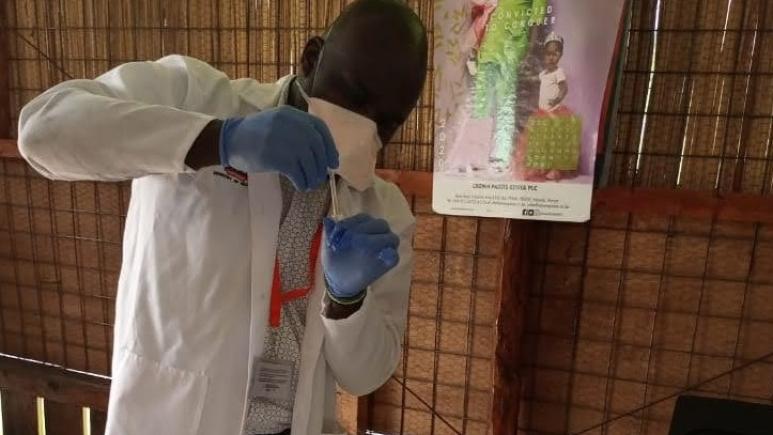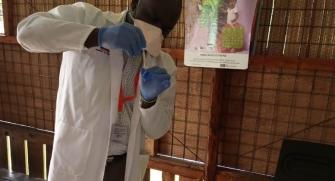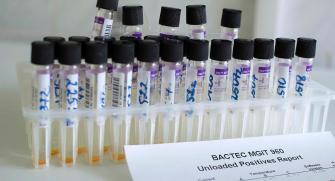Diagnostic urine test for tuberculosis: a fluid that is easy to obtain and very well accepted by patients
Tuberculosis, particularly in people living with HIV, remains largely under-diagnosed and therefore untreated. One of the reasons for this is the lack of access in resource-limited countries to simple, inexpensive, high-performance diagnostic tests that are readily accepted by healthcare professionals and patients. For people living with HIV, this is compounded by the difficulty of producing the sputum required for automated molecular diagnosis using the Xpert MTB/RIF(1) method, or for microscopic analysis. Rapid urinary LAM (lipoarabinomannan) tests, which look for a biomarker in urine samples, therefore appear to be a promising alternative. However, until now there have been no studies on patient acceptance of urine as a sample for the diagnosis of tuberculosis.
Patient acceptability and perception
Epicentre conducted a multi-country study of TB diagnosis in people living with HIV in 4 sites with high prevalence of HIV and TB: Mbarara Regional Referral Hospital in Uganda, Homa Bay District Hospital in Kenya, Alto Maé Health Centre in Maputo, Mozambique, and Eshowe Gateway Clinic and District Hospital in Eshowe, KwaZulu-Natal, South Africa.
An initial finding confirms the added value of urine samples for rapid urine tests compared with tests requiring sputum: only 50% of the people in the study were able to produce sputum spontaneously. However, all patients were able to provide urine samples easily.
While the diagnostic accuracy of a test is key, patient acceptance is just as essential, although often overlooked, especially when the test requires the collection of bodily fluids that may run counter to social norms or cultural values. With regard to urine sampling for use in diagnosing tuberculosis, the collection of patient perceptions highlighted the following points
Positive factors:
- Obtaining a urine sample is easy, natural, quick and painless,
- Urine is often preferred to sputum, leading to less stigmatisation
- Obtaining the results of rapid urine tests on the same day, which reduces the emotional, physical and financial burden of having to return to a health facility.
As one of the participants in the Ugandan study explained in relation to tests using sputum, " There is that particular sputum sample that is needed. Even if you have it in the throat, it is hard to produce. They may ask you for sputum and you instead provide saliva. But for urine, it is easy to provide the sample."
And a South African participant notes the importance of getting the result within a day "[rather] than to come back the next day because of money for transport and time. As we are sick, we need not to overwork ourselves by keeping on coming here. It is better to just go to the hospital and be prepared to wait. Same day can be better and easy because you want to know what is happening and be free, it must not take long. [If] I must wait [longer than a day], maybe I would get even more sick because of the wait."
What is needed for the test to be carried out in good conditions:
- Need for clean toilets and privacy
And limits:
- Waiting for access to the toilet
- A slightly higher level of mistrust in the results of urine-based tests for tuberculosis than in those based on sputum due to a less obvious association for patients between the urinary tract and tuberculosis.
But the use of toilets has another advantage, as one participant from South Africa explained "If you do not like people to see what you are doing you go to the toilet, take urine, and hide it. While with sputum, a person can hear you coughing and feel disgusted."
In conclusion, urine sampling is very well accepted and even beneficial for patients in terms of comfort and privacy. In order to further improve perceptions, the study noted a number of patient needs and concerns that should be taken into account with a view to implementing urine testing on a large scale:
- provide instructions and information on sampling and testing, as well as equipment for carrying it out
- provide a clean, private, nearby and functional place (toilets) and infection prevention facilities (water, toilet paper, hand-washing points) for taking samples
- offer the test free of charge
- guarantee same-day diagnosis and treatment for people who test positive, ensuring that the results are communicated confidentially,
- fostering a quality relationship between the medical team and the patient, which means that medical staff must have the time, skills, awareness and encouragement to behave in this way.
"It is by taking these recommendations into account that the deployment of urine tests for the diagnosis of tuberculosis can be carried out effectively. These results are all the more important given that several tests based on urine samples are currently being developed and, if implemented under the right conditions, should help to reduce the under-diagnosis of this infectious disease," concludes Helena Huerga.
(1) Automated molecular diagnostics such as Xpert MTB/RIF performed on sputum show good performance, but because of their cost, the need for electricity and the laboratory infrastructure required, they are not widely available in some resource-limited settings where, as a result, diagnosis still often relies on clinical signs and sputum microscopy.










